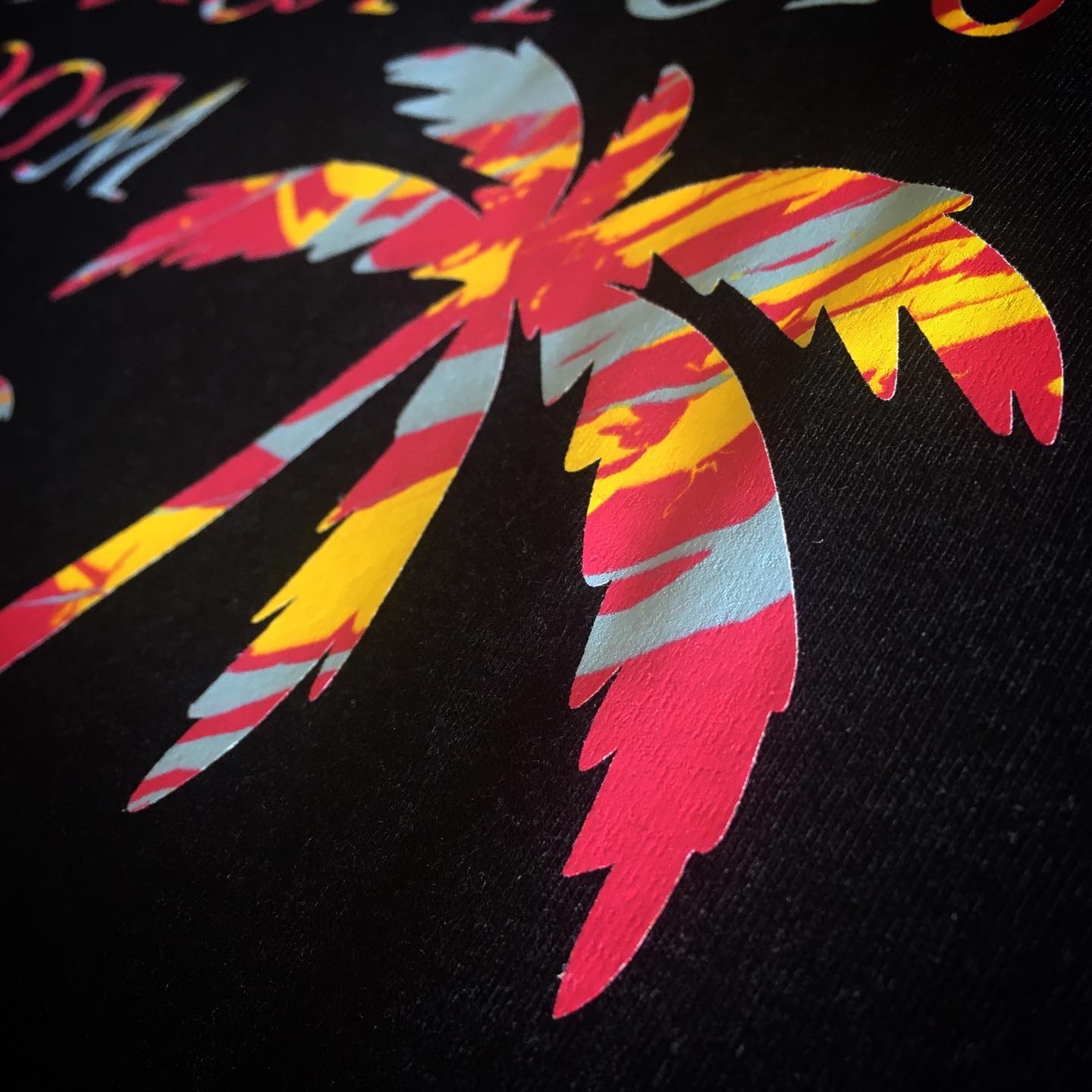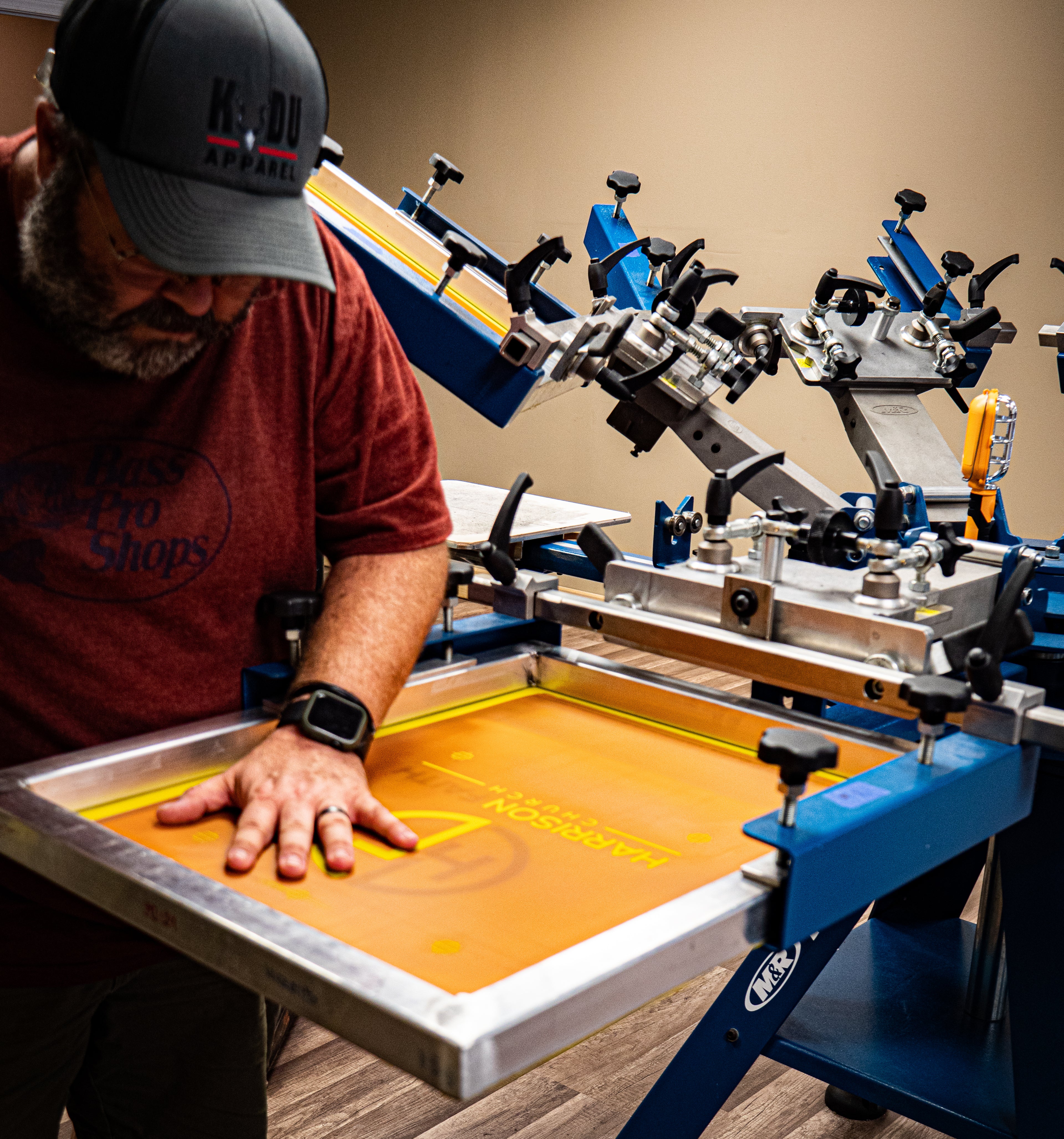High-Quality Custom Screen Printing for Team Apparel
High-Quality Custom Screen Printing for Team Apparel
Blog Article
Screen Printing Uncovered: Whatever You Need to Understand About Tee and Garment Printing Techniques
If you have actually ever before wondered how those dynamic styles end up on your favorite tee shirts, you remain in the best place. Display printing is a remarkable approach that integrates art with technique, offering countless possibilities for imagination. Understanding the basics, from devices to ink options, can greatly affect your results. Ready to explore the essential components that make display printing an art type? Let's reveal the details that can elevate your jobs.
The Basics of Screen Printing: How It Functions
When you plunge right into screen printing, you'll uncover it's both a science and an art. At its core, display printing entails developing a stencil, or display, that allows ink to pass with only in certain locations (screen printing kit). You start by choosing your design and preparing your screen with a light-sensitive solution. As soon as you subject this solution to light, it solidifies, leaving your design as an unfavorable room.
Following, you'll blend your inks and prepare your printing surface area. Setting the display over the fabric, after that use a squeegee to press ink through the screen onto the garment. This process needs accuracy, as you desire clear, dynamic prints. After printing, you'll heal the ink with warm, ensuring it sticks to the fabric and lasts with cleans. Each step is vital, and understanding them will elevate your screen printing skills, transforming basic garments right into special, meaningful items.
Sorts Of Display Printing Strategies
Once you comprehend the basics of display printing, it's time to explore the different strategies that can raise your designs. One preferred method is typical screen printing, where ink is pressed through a stenciled display.
If you're going for great information, take into consideration discharge printing. This technique gets rid of dye from the textile, leaving a soft, vintage appearance. Another choice is plastisol printing, known for its toughness and vibrant shades, making it a preferred for several brand names. Ultimately, trying out halftone printing to develop gradient effects and detailed layouts. Each method has its special beauty, so do not think twice to attempt them bent on find what suits your style best!
Important Equipment for Screen Printing
To achieve sensational results in screen printing, having the appropriate tools is basic. You'll need a durable display printing framework, which holds the mesh that transfers your layout onto the garment. Next, spend in high-quality mops; these are necessary for applying ink equally across the display.
Choosing the Right Inks and Materials
When selecting inks and materials for screen printing, you require to think about the kind of ink that works finest for your project. Consider textile compatibility to guarantee your styles look last and fantastic lengthy. Also, check out environment-friendly ink alternatives to make your printing process a lot more lasting.
Kinds Of Screen Inks
Picking the ideal display ink is crucial for accomplishing vivid, resilient prints that fulfill your project's demands. There are several sorts of display inks to analyze. Plastisol ink is preferred for its adaptability and simplicity of usage, offering exceptional shade opacity on dark textiles. Water-based ink, on the other hand, offers a softer feel and is green, making it excellent for those looking to lessen their environmental impact. Release inks get rid of color from the textile, causing a soft, vintage appearance yet require specific handling. Ultimately, specialty inks, such as metal or glow-in-the-dark, can add special results to your styles. Review your job requirements and select the ink that straightens ideal with your wanted result.

Material Compatibility Factors To Consider
Understanding material compatibility is important for attaining top notch display prints, especially because various products react uniquely to various inks. When picking inks, consider the fabric type-- cotton, polyester, or blends. For cotton, water-based inks work well, offering gentleness and breathability. Polyester, on the various other hand, often calls for plastisol inks for much better attachment and vivid colors. If you're publishing on blends, you might require to use a mix of both types. Always check your inks on example material to ensure they adhere effectively and preserve color integrity. Furthermore, bear in mind that textile weight and appearance can impact the final outcome, so selecting the right ink and product combination is important for your project's success.
Eco-Friendly Ink Options
Environmentally friendly inks are ending up being a preferred selection for display printers that want to lessen their ecological effect while keeping quality. When choosing inks, take into consideration water-based inks, which are less harmful and much easier to cleanse up contrasted to standard solvents.
Furthermore, try to find inks made from sustainable sources, such as soy or vegetable-based choices. By choosing the ideal inks and materials, you'll not just create sensational layouts however also add to an extra lasting printing procedure. Make the switch, and your prints will reflect your commitment to the environment!
Preparing Your Style for Screen Printing

Submit Format Requirements
To assure your design looks sharp and lively on material, you'll require to pay attention to file layout requirements for screen printing. Beginning with vector documents like AI or EPS, as they can be scaled without losing top quality. If you use raster pictures, select high-resolution files, such as TIFF or PNG, preferably at 300 DPI. Stay clear of using JPEGs, as they can lose clarity when resized. Make sure your layout has a transparent background to protect against unwanted white edges on your prints. Finally, keep color modes in mind; CMYK is basic for screen printing, so convert your RGB develops appropriately. By adhering to these standards, you'll set your artwork up for a successful print.
Color Splitting Up Strategies
Shade separation is a vital step in preparing your style for display printing, and mastering it can significantly enhance your print quality. You'll require to damage your layout into private shades, as each color calls for a separate screen during printing. This accuracy not just assures exact color depiction yet also enhances the printing procedure.
Resolution and Dimension
Accomplishing the finest lead to screen printing starts with guaranteeing your design has the best resolution and dimension. Ideally, your artwork should be at the very least 300 DPI (dots per inch) for sharp, clear prints. If you make use of reduced resolution, your final item could look less than professional and pixelated.
When it pertains to size, take into consideration the dimensions of your print area. Layout your artwork to match the last print size, ideally developing it in the real dimensions you'll be publishing. This method, you'll stay clear of any kind of unexpected scaling issues.
Constantly examine your design in both vector and raster styles. Vector graphics can be scaled without losing quality, making them excellent for screen printing. Preparing properly will ensure your layout looks amazing on every garment!
Step-by-Step Screen Printing Refine
Screen printing is a dynamic process that allows you to produce dynamic layouts on different surface areas. To get going, you'll require a display, emulsion, and your chosen ink. Prepare your screen by cleaning it thoroughly. Next off, apply the emulsion equally and let it dry in a dark area. Once dry, reveal your screen to light with your design positioned on it, which will certainly solidify the custom screen printing emulsion where the light hits, developing a stencil - screen printing kit.
After washing out the unexposed emulsion, your display is prepared. Establish it up on your printing surface area and straighten your garment beneath it. Put ink onto the screen and use a squeegee to push the ink with the pattern onto the fabric. Lift the display thoroughly and allow the print dry. Ultimately, cure the ink utilizing warm to assure sturdiness. That's it! You've efficiently screen published your style.
Tips for Successful Screen Printing Projects
While you're diving right into your display printing tasks, bear in mind that preparation is crucial to success. Beginning by collecting all your materials-- inks, mops, displays, and garments. A tidy office helps stop unwanted mistakes, so neat up prior to you start.
Next, validate your art work is high-resolution and correctly sized for your garment. Evaluate your display for appropriate direct exposure and tidy it thoroughly to prevent smudges. When blending your inks, follow the producer's standards to attain the best uniformity.
During printing, apply also pressure with your squeegee for regular outcomes. Don't rush; take your time to confirm each print satisfies your criteria. After printing, let your garments dry completely prior to handling or packaging them.
Last but not least, constantly maintain an example of your benefit future referral. This method, you can evaluate your progress and enhance your strategies over time. Satisfied printing!

Frequently Asked Questions
How Lengthy Does It Require To Establish a Screen Printing Job?
Establishing a screen printing work normally takes about 30 minutes to an hour. You'll prepare the screens, mix inks, and adjust journalism. The moment differs based on complexity and experience, so remain arranged!
Can I Print on Different Textile Enters Making Use Of the Exact Same Strategy?
Yes, you can publish on different material types utilizing the exact same strategy, however you'll require to adjust your setups and inks. Some materials take in ink in a different way, so experimenting guarantees the very best results for every material.
What Prevail Errors to Avoid in Screen Printing?
When display printing, prevent typical blunders like utilizing the incorrect ink, neglecting correct exposure times, or missing pre-press checks. Always check your arrangement and keep tidy displays to ensure top quality results each time.
Exactly How Can I Effectively Clean and Preserve My Display Printing Equipment?
To correctly tidy and keep your display printing equipment, you ought to frequently clean displays with ideal solvents, check squeegees for wear, and ensure all devices are saved dry and dust-free. Uniformity avoids pricey repair work and improves performance.
Is Display Printing Eco-friendly Compared to Other Approaches?
Screen printing can be extra eco-friendly than other approaches, especially if you utilize eco-conscious products and water-based inks. By selecting sustainable materials and practices, you reduce waste and reduce your impact on the planet.
Display Printing Uncovered: Everything You Required to Know Regarding Tee Shirt and Garment Printing Methods
At its core, screen printing includes producing a pattern, or display, that permits ink to pass via just in specific locations. Position the screen over the fabric, then utilize a squeegee to press ink through the screen onto the garment. One prominent technique is standard screen printing, where ink is pushed with a stenciled display.When selecting inks and products for screen printing, you require to take into account the type of ink that works finest for your project.
Report this page